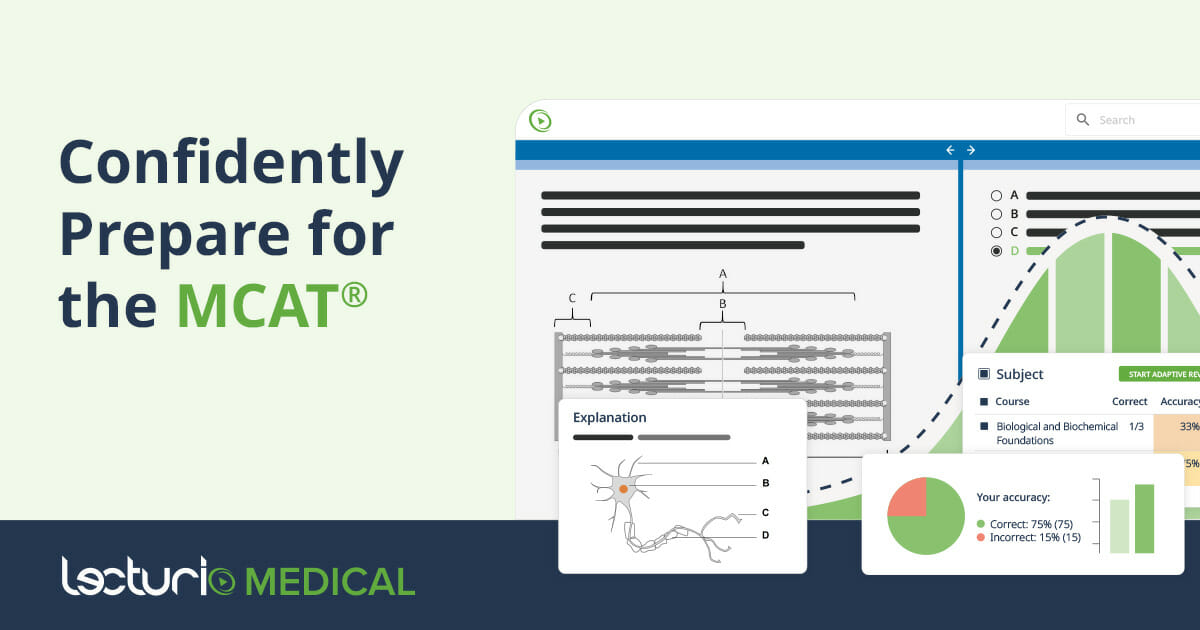Whether you’re a pre-med student on your first MCAT attempt, a retaker aiming for a higher score, an international student aspiring to study in the U.S. or Canada, or simply exploring MD/DO programs for a possible career in medicine– This article may be what you’re looking for. We’ll discuss how the MCAT is scored, a guided approach to tackling it, and how to get the best possible score you can!
So what’s the point of knowing how the MCAT scoring works? Why can’t students just take the exam and try to get the highest score possible? You can do that. But taking an exam without knowing how it’s scored is like playing a sport without knowing how to get points. You have to strategize the best way to approach the exam to get the score you want. Apart from that, if you’re looking to get into a top school, they have high cut-offs. You’ll have to set your expectations and even plan your back-up schools that fit your personal goals and ideal location.
Understanding MCAT Scores and Percentiles
The MCAT (Medical College Admission Test) is a computer-based, multiple-choice exam. Your correct answers produce raw scores that will be converted to scaled scores from 118 to 132 (per section). Meanwhile, your wrong answers are scored as if you hadn’t answered at all. In other words, there is no penalty for giving a wrong answer. So it’s better if you answer every question, even if you’re not sure. Each score conversion depends on the set of questions in the test form. The test is made in a way that even when two students of equal skill and knowledge have different sets of questions, their scaled score should be the same.
When you receive your MCAT Scores, you receive five scores: 4 scores for each section and 1 total score. This is to help you figure out which subject needs more work should you retake the exam or simply want to assess yourself. The MCAT is split into 4 sections:
- Biological and Biochemical Foundations of Living Systems
- Chemical and Physical Foundations of Biological Systems
- Psychological, Social, and Biological Foundations of Behavior
- Critical Analysis and Reasoning Skills
The lowest for each section is at 118 and the highest at 132, with the midpoint being 125. These scores sum up to make your total score that ranged from 472 to 528, with the midpoint being 500. In other words, a score of 125 on each section or a score of 500 total will give you a percentile near 50. That means you performed at a level at or above 50% of the people who take the test. Percentile is a relative ranking, not a percentage of the score you get. If you’re not performing up to par with your fellow students or higher, you may want to retake the exam.
So where do they get the relative rankings? Relative to what? The relative scores are based on the applicants from the most recent 3 years. For example, people who take the exam in 2025 will be compared to those who took the exam from 2022 to 2024. You may be wondering, what is considered as average or outstanding percentile scores? The AAMC doesn’t provide clear cut-offs for ‘average’, ‘good’ or ‘outstanding’ scores. But based on how AAMC computed for acceptance rates, the difference between average to above average to good ranges (and so on) can mean almost a 10% better acceptance rate (with a good GPA).
- Average scores could be considered the 50th to 65th percentile (500 total points).
- Above average scores could be considered the 68th to 77th percentile (506-509 total points).
- Good scores could be considered the 79th to 87th percentile (510-513 total points)
- Great scores could be considered the 89th to 94th percentile (514-517 total points)
- Excellent scores could be considered above the 94th percentile (517+ total points)
Competitive Scores for Medical School Admissions
All schools want the best-performing students. However, some schools will have a lower minimum MCAT score than others. Take note that there are also other factors for school acceptance apart from your MCAT results and GPA.
Most Competitive MD Programs
These schools are more selective with their programs. Their median MCAT scores for their accepted applicants range from a score of 518 and above while the average GPA required can range from 3.8 to 3.98. So make sure to research your first-choice of school and their grade requirements. Here are a few examples of these highly competitive schools, based on their recent acceptance data:
| Medical School | GPA | MCAT |
| New York University Grossman School of Medicine | 3.98 | 523 |
| Yale School of Medicine | 3.92 | 522 |
| Johns Hopkins University School of Medicine | 3.94 | 520 |
| University of Chicago Pritzker School of Medicine | 3.4-4.0 | 505-527 |
| Perelman School of Medicine University of Pennsylvania | 3.49-4.00 | 514-528 |
| Harvard Medical School | 3.9 | 520.42 |
Highly Competitive MD and DO Programs
These schools have lower median GPAs and MCAT scores to enter compared to the ones mentioned above. But they are no less selective of their students. The median MCAT scores for these schools can range from 512-517 for MD programs and 504-508 for DO programs. Some of these schools include:
Canadian Schools and Score Ranges
Not all schools in Canada require an MCAT Score. Some of these schools will rely more on your GPA and where you’re from since most schools in Canada tend to prioritize residents of their respective areas. Some schools that don’t require MCAT include (but are not limited to):
- University of Ottawa Faculty of Medicine
- Northern Ontario School of Medicine
- McGill University Faculty of Medicine
Most schools do require an MCAT Score and that can range from 506 to 516. If you want your best chance to get in, as someone outside Canada, you’ll want to aim for a score above the highest (516). For example, the University of Manitoba Rady Faculty of Health Sciences has a median score of 511 for resident applicants, but a 522 median score for out-of-province applicants. This means that it will be a lot more competitive for those who don’t live in their school’s province.
How Medical Schools Evaluate Scores
Apart from your MCAT Scores, schools will compare them to your GPA. So you need a high score for both or, if you have a less competitive GPA, make up for it in an even higher MCAT score. So based on your GPA, you can somewhat estimate the MCAT score you need to increase your chance of acceptance in the school of your choice.
Does being an MCAT retaker affect my chances?
Retaking the MCAT is common, especially for those who felt ill-prepared for their last attempt. In fact, a significantly improved score would be favorable to schools because it shows that you’re capable of improving. However, multiple attempts with minimal improvement may be seen unfavorably by schools.
Does applying late affect my chances?
Medical schools receive thousands of applications from inside and outside of the U.S. So while the schools are accepting students, they fill slots and their waiting lists. Applying around August (or later) means that you’ll be competing with other late applicants for even less slots. Admissions will spend less time going through the late applications, since many will be moving to the interview phase. So unless you’re a strong competitor and extremely lucky, it’s more advisable to apply as early as possible.
Proven Methods to Improve Your MCAT Score
The MCAT requires meticulous preparation to pass. It’s crucial to make use of all your resources and find sufficient time to study for it. But even then, it’s a lot of information to take in. Here are some tips that can help you retain it all:
#1: Use spaced repetition
Resist the temptation to cram at the last minute and start studying for your MCAT early (ideally 5-6 months). While cramming may get you through exams in the short-term, MCAT makes use of your long-term recall, which works better with spaced out study. Spaced repetition is the best way of doing this. You can learn a bulk of information over a long period of time, reinforcing long-term memory recall. Thankfully, Lecturio has a spaced repetition system that helps you make the most of your learning experience!
#2: Do practice exams
Knowledge is a huge part of the test, but half the battle is testmanship. Use sample tests and question banks practice with a time limit to train you for the real thing. Go through as many questions as you can to sharpen how you analyze questions. For some examples, you can try out Lecturio’s MCAT Question Bank, which leads us to our next tip…
#3: Assess your weaknesses
It’s only through testing yourself that you know what subjects you feel the least confident. If you find yourself stuck on a certain question, it’s good to take a mental note to read up on it later on. You need to cover as much ground as possible to get the best score. Keep on practicing and filling in your knowledge gaps!
#4: Leverage active learning techniques
Lastly, we have active learning techniques. One of the more effective ways to do this is to teach back concepts and summarize content. This can be done when you summarize your notes, repeat back concepts with studymates or classmates, or some even repeat back lessons to their pets (based on personal experience). Summarize your notes. Draw pictures and diagrams. As long as it helps you understand concepts rather than simply memorizing it, you’ll have more productive study sessions.
Common MCAT Study Pitfalls to Avoid
Apart from the aforementioned cramming, a common pitfall students have is using passive study methods. This includes simply watching videos, skimming through textbooks, or passively highlighting handouts, resulting in low-quality retention. It’s easy for information to go into one ear, but it’s hard to keep it from coming out the other. Instead, practice active recall. Really try to read, understand, and build connections between different concepts. Repetition and comprehension is key!
Another common mistake students make is neglecting the CARS (Critical Analysis and Reasoning Skills) Section of the exam. It’s a misconception that this section only focuses on innate learning aptitudes. While it’s true that you don’t need any specific knowledge to answer the questions, your reading comprehension will be tested– and that’s a skill that must be honed. Read different types of literature and understand what’s in the passage and beyond it. Think of the author’s intention. Additionally, try to make use of sample tests to get a better idea on how you can approach these questions.
MCAT Improvement Timeline
Making a realistic timeline for the MCAT really depends on the baseline knowledge level of the student. If you come from a more medical or biological educational background, you’ll likely have an easier time studying for the Biological Systems section. But does that mean you’ll need less time to study for that section? Not necessarily. You should still review subjects you’re familiar with to reinforce it into memory. Complacency is the enemy of success.
There are MCAT prep courses online that can range from 1 month, 3 months, or even 6 months. Find a schedule that best fits your needs. Some students still attend classes or work while preparing. Others take time off to prepare for the MCAT. The most common amount of time spent for studying is around 3 months with around 15-20 hours of studying per week.
Start with a practice or diagnostic test and score yourself. Then, work your way up to your desired score. Try to take MCAT practice tests every 1-2 months to check your improvement and where your weaknesses lie. Ideally you should be covering all your subjects for the first few months, then covering everything you find difficult in the last month before your exam.
If you’re not sure where to start, you can maximize your MCAT score improvement by enrolling in Lecturio’s expert-designed MCAT preparation course.
For those retaking the MCAT, it’s highly discouraged to retake the exam immediately (around 1-3 months) after your last exam. Often, students who do this get a score too close to the last one or they get an even lower score. Take time to step back and assess what may have gone wrong. Many students take 5 months or even a year before retaking their exam with positive results.
Conclusion & Next Steps
So, what have we learned? The MCAT questions are scored depending on their difficulty. Your score and GPA matter in your acceptance to medical schools, which are highly competitive. So, research your target school’s acceptance data and consider having back-ups.
Before you start studying, gather all the resources available to you. Use them to cover the subjects as much as you can (even the CARS section). Assess your performance using practice exams and polish on your weaker subjects.
For retakers, time your retakes in a way that it gives you time to rest and recover. You need to review what you may have missed, what subjects you consider your weak points, and what you can change in your strategy the next time around.
Now that you have a basic understanding of the MCAT scoring system and ways to improve your own score, it’s time to take the next step: Start with Lecturio’s MCAT practice exam to know where you currently stand. You can receive a comprehensive report for subjects that need more attention when you continue with your studies. From there, you can follow their MCAT study guide or make one for yourself. It’s all about finding the strategy that works best for you. Best of luck!




